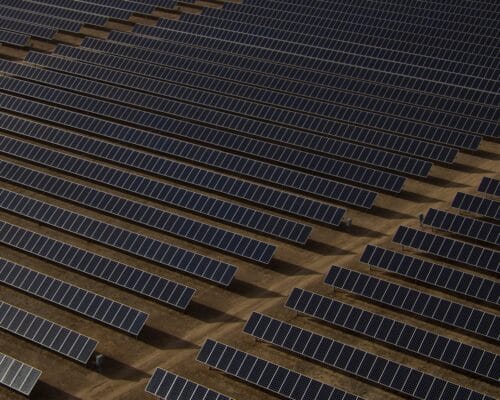South Korea Prepares for Net-Zero by 2050. But Is It Enough?
01 October 2021 – by Viktor Tachev
South Korea is among the ten most innovative countries in the world, according to the Global Innovation Index 2020. However, the country is way behind the leading pack when it comes to power mix and energy policies progress. While South Korea aims for net-zero by 2050, its plans leave a lot to be desired compared to global renewable energy leaders. Although the country still has time to rethink its green energy strategy, it has some serious choices to make, starting with its net-zero commitments.
The State of the Energy Mix of South Korea
South Korea’s power sector is heavily reliant on fossil fuels. According to IEA, as of 2018, over 85% of the installed capacity was attributed to oil, coal, and natural gas.
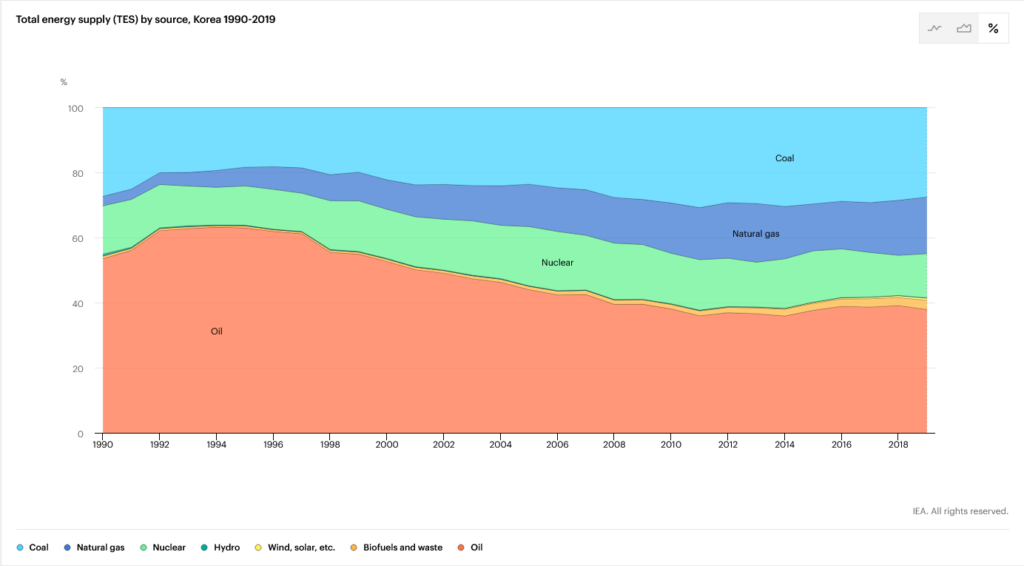
Ember Climate points out that, in 2020, the share of fossil fuels in the total energy mix equalled 66%. Of that, coal held 36%, while oil and gas collectively accounted for 30%. Furthermore, Ember Climate’s analysis finds that South Korea generated more electricity from fossil fuels in 2020 (353 TWh) than in 2015 (350 TWh). The share of natural gas increased from 22% to 27% during the particular period. The disturbing statistic is that gas has risen more than coal has fallen in the last five years.
Figures by the Korea Energy Economics Institute (KEEI) of February 2021 divide the country’s current energy mix as follows: oil (37 %), coal (21.8 %), LNG (23.7 %), nuclear power (11 %) and renewables (6.4 %, the lowest among OECD members).
Compared to other G20 countries, South Korea phases out coal much slower. Over the period 2015-2020, it has reduced coal generation by 10%. This is much lower than the 15% for Japan, 48% for the EU-27 countries, and 93% for the UK.
The (Lack of) Progress on the Renewable Energy Stage and the Net-Zero by 2050 Journey
In 2018, Korea had the lowest share of energy from renewable sources in energy supply among all IEA countries. Currently, only 3.8% (21 TWh) of the country’s electricity generation comes from wind and solar. In G20 countries, only Saudi Arabia fares worse.
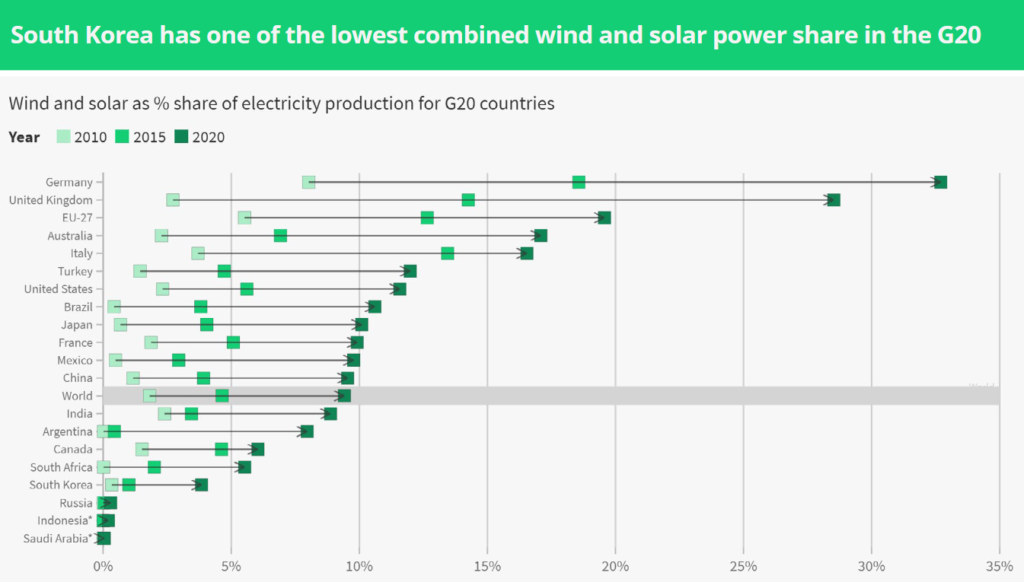
South Korea also lags behind the world’s median on progress to 100% clean electricity. While it outpaces the global median on phasing out coal, the country’s efforts have, slowed down from 41% in 2015 to 36% in 2020. According to figures from the OECD, currently, renewable energy accounts for only 2% of the primary energy supply in South Korea, the lowest in the OECD.
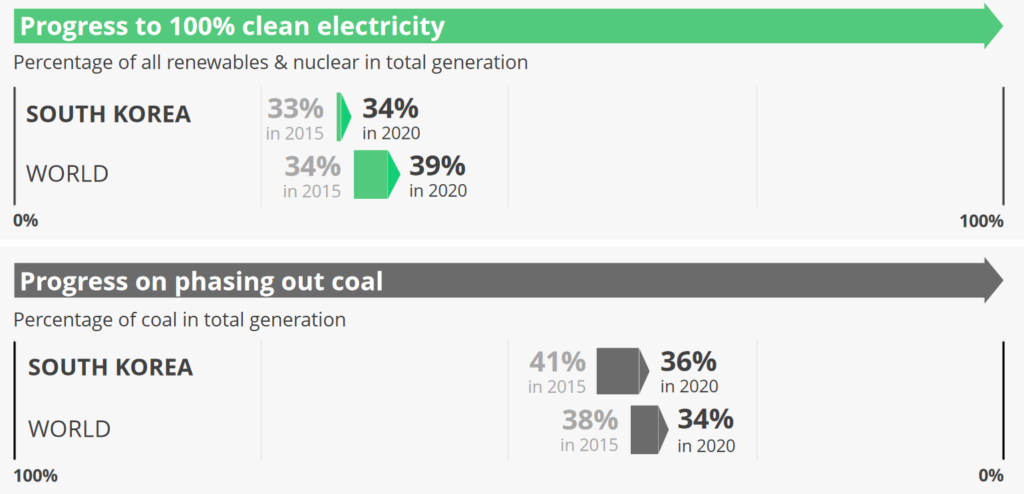
South Korea’s NDC, the Green New Deal and the Developments on the Policy Front
The country’s lack of progress with the renewable energy transition is addressed through various programmes and policies. While this is admirable, the question that remains is how successful they will be.
South Korea’s NDC
In 2020, South Korea submitted its 2030 Nationally Determined Contributions (NDC) target to the UN. However, it did not improve its already low and outdated target of 24.4% 5 years ago. For comparison, the US plans to cut emissions by 50% by 2030 from its 2005 levels. On the other hand, Japan pledged to a 50% emissions cut by 2030 compared to 2013. As a result, South Korea’s target received international backlash considering the lack of progression beyond the past NDC target and its failure to show ambition.
Cuts in South Korea’s Greenhouse Gas Emissions
South Korea’s ruling party has proposed a target to cut greenhouse gas emissions at least 40% by 2030, compared to 2017 levels. However, even those figures, which appear to be the most ambitious to date, remain way below the 59% mark, suggested as the desirable target by Climate Analytics.
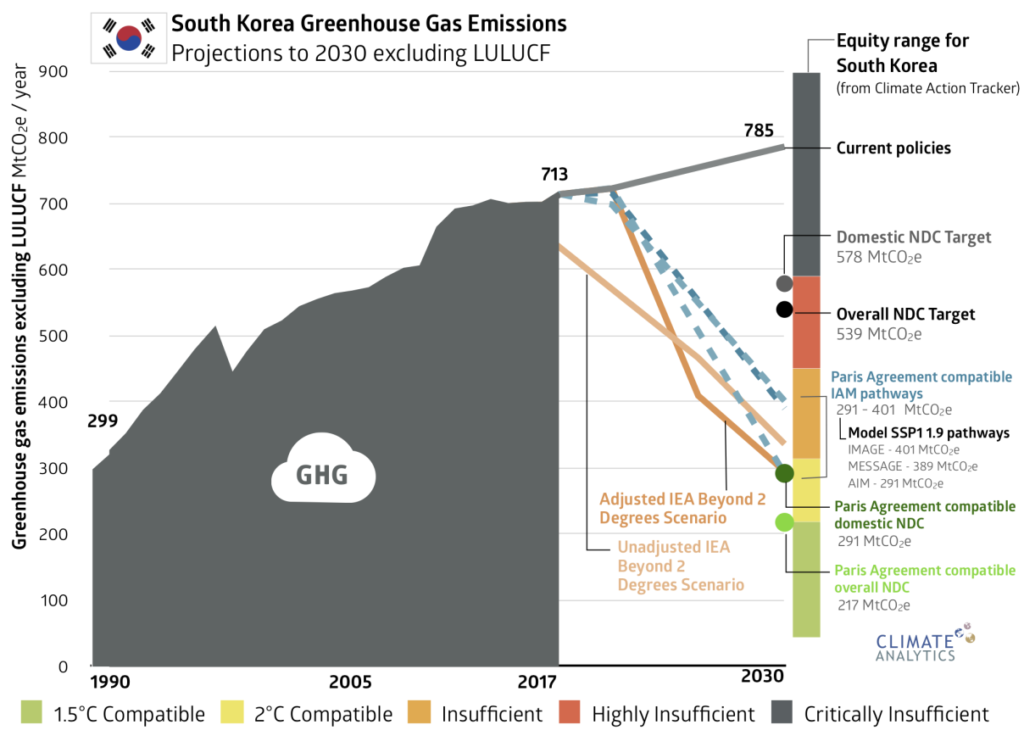
Aware of criticism about the country’s weak ambition, in May 2021, Moon Jae-in, President of South Korea, declared that a more ambitious target would be announced at the COP26 conference on climate change in Glasgow in November 2021. However, so far, there is no additional information about the concrete targets. According to a press release by the Ministry of Ecology of South Korea, “the level set for the target to be enhanced will be set through discussions and dialogues with the relevant bodies, based on the 2050 carbon neutrality scenario.”
The Green New Deal
In response to the pandemic, to help the country’s economy recover from the COVID-19 recession, the Korean government announced its Green New Deal on 14 July 2020. The programme has a budget of approximately USD 61.43 billion. Green infrastructure, low-carbon and decentralised energy and innovation in green industries will have the highest priority in terms of investment. The plan will promote commercial technology development for large-scale carbon capture utilisation and storage (CCUS) by 2023.
Alongside the Fifth Renewable Basic Energy Plan, it became a leading policy trend and a sign of a governmental commitment to reducing the country’s dependence on nuclear and fossil fuel while pushing renewables. The Korean Green New Deal sets out three main strategic objectives. These include green urban development, low-carbon decentralised energy and innovative green industry. It targets several projects, including green remodelling, renewable energy, eco-friendly mobility, smart grid and green industrial complexes.
The Challenges Ahead in Front of South Korea’s Quest to Net-Zero by 2050 and What to Expect
Two main challenges are looming over South Korea’s net-zero by 2050 journey.
First, current policies fall short of reaching carbon neutrality by 2050. Furthermore, according to the Korea Advanced Institute of Science and Technology (KAIST) and Solutions for Our Climate (SFOC), they also aim at a “highly insufficient” 2030 emissions target. If the government does not improve the targets, South Korea risks becoming one of the most developed countries with the worst green policies and slowest renewable energy progress globally.
Next comes implementation. So far, South Korea has been struggling with implementing solid green energy policies compared to other OECD countries. However, if the country successfully implements its Green New Deal, it will notably accelerate its clean energy transition. Furthermore, according to IEA, it will get at the forefront of some of the energy industries in the future.
From High Pollution to Net Zero Emissions
Overcoming these challenges is imperative for South Korea. As of 2016, the country was the third-highest polluter in the world per capita. It was also the fourth largest coal importer and the third biggest public investor in overseas coal plants.
While the country’s plans are indeed ambitious, they will remain just plans until we start seeing their fruits. However, if there is one country with the innovations, capacity and financial power to achieve net-zero by 2050, it is South Korea.
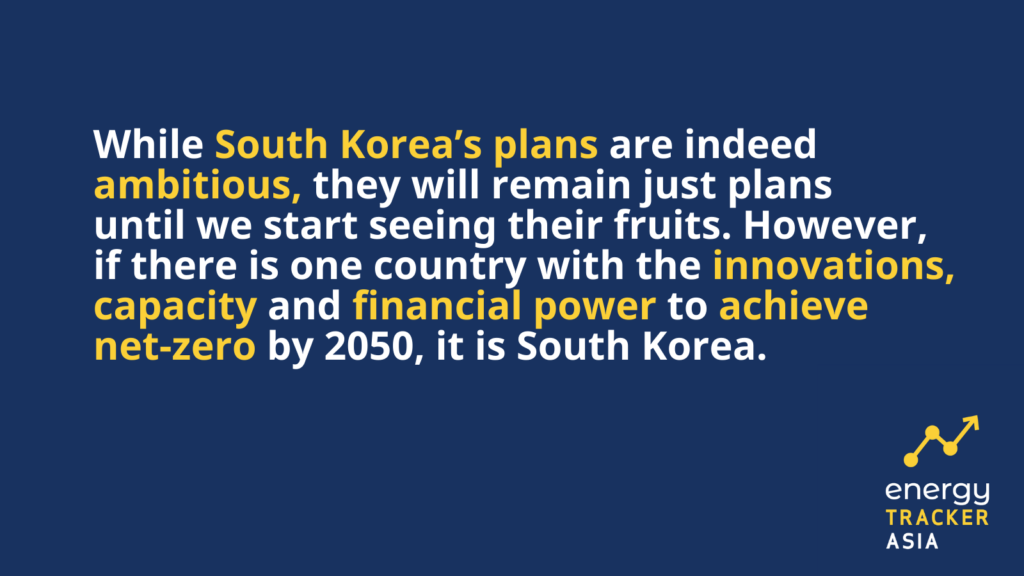
by Viktor Tachev
Viktor has years of experience in financial markets and energy finance, working as a marketing consultant and content creator for leading institutions, NGOs, and tech startups. He is a regular contributor to knowledge hubs and magazines, tackling the latest trends in sustainability and green energy.
Read more